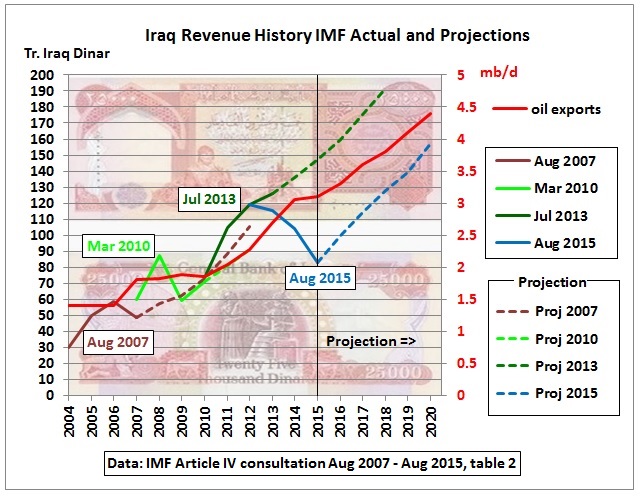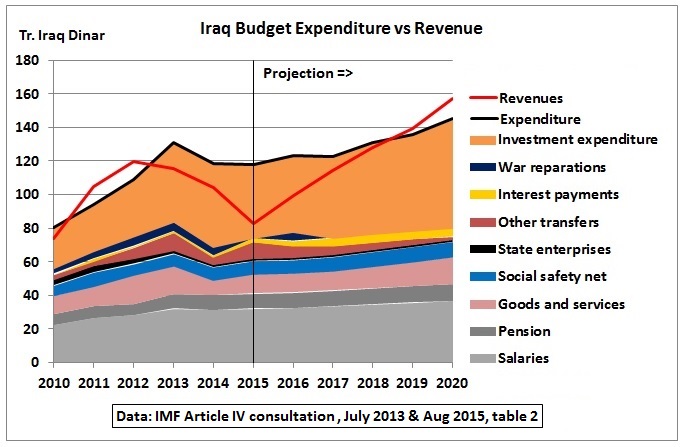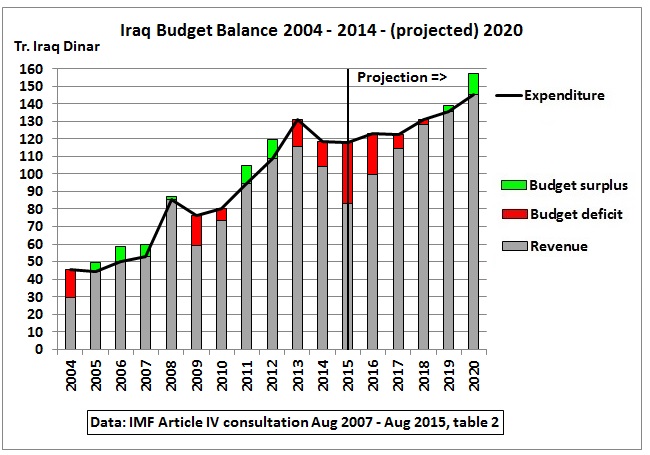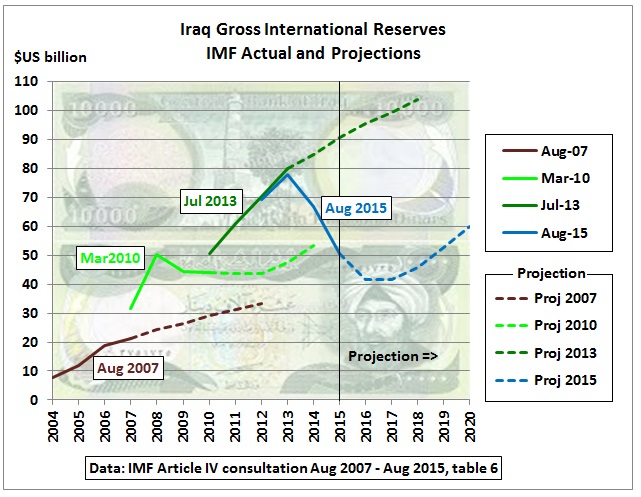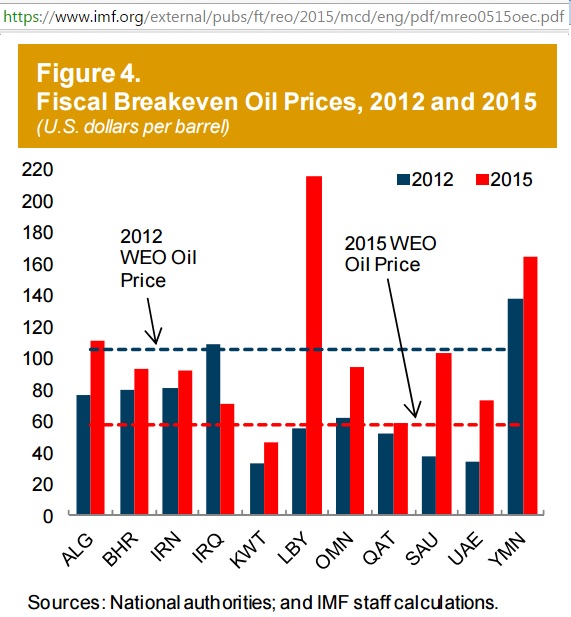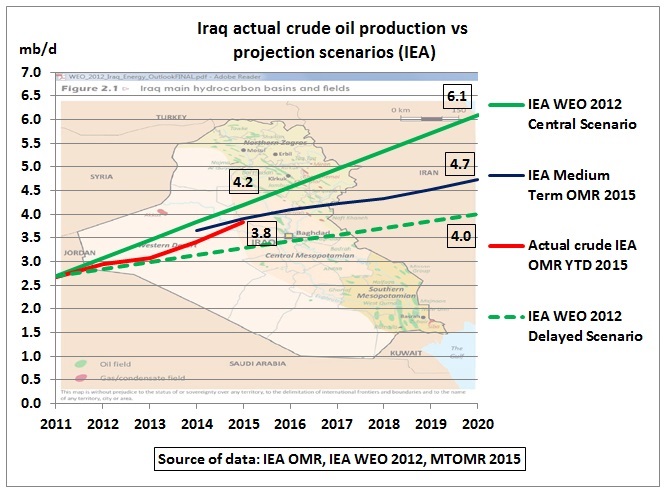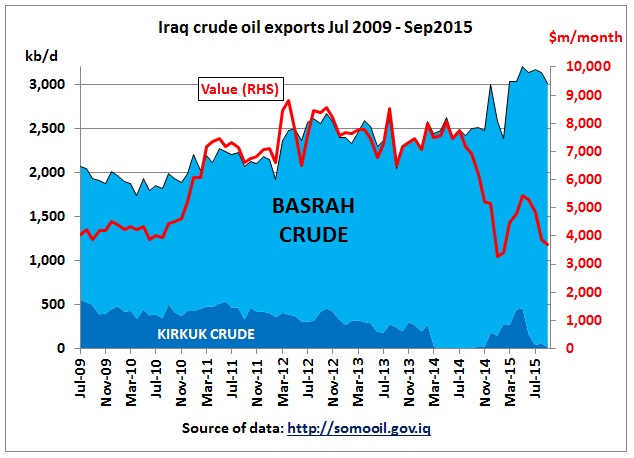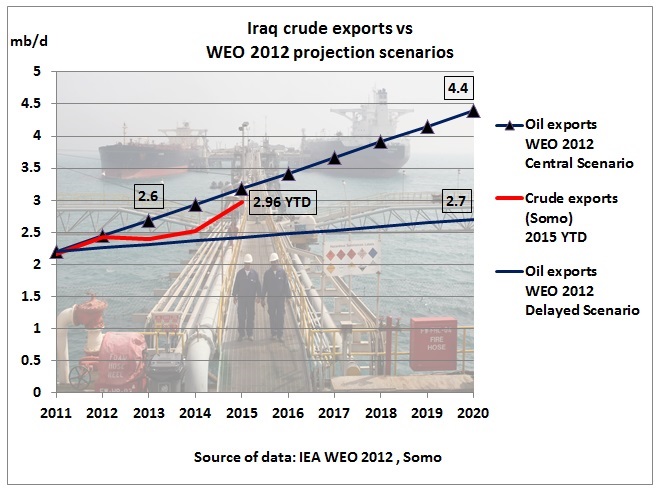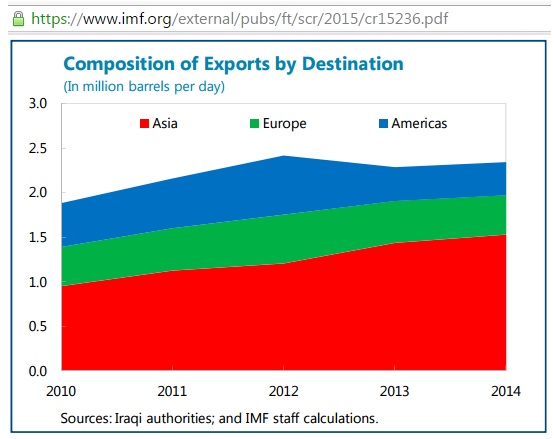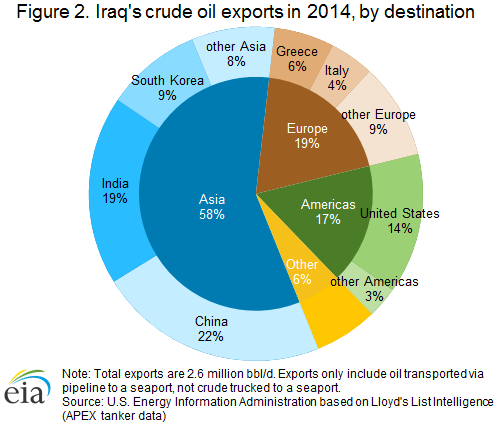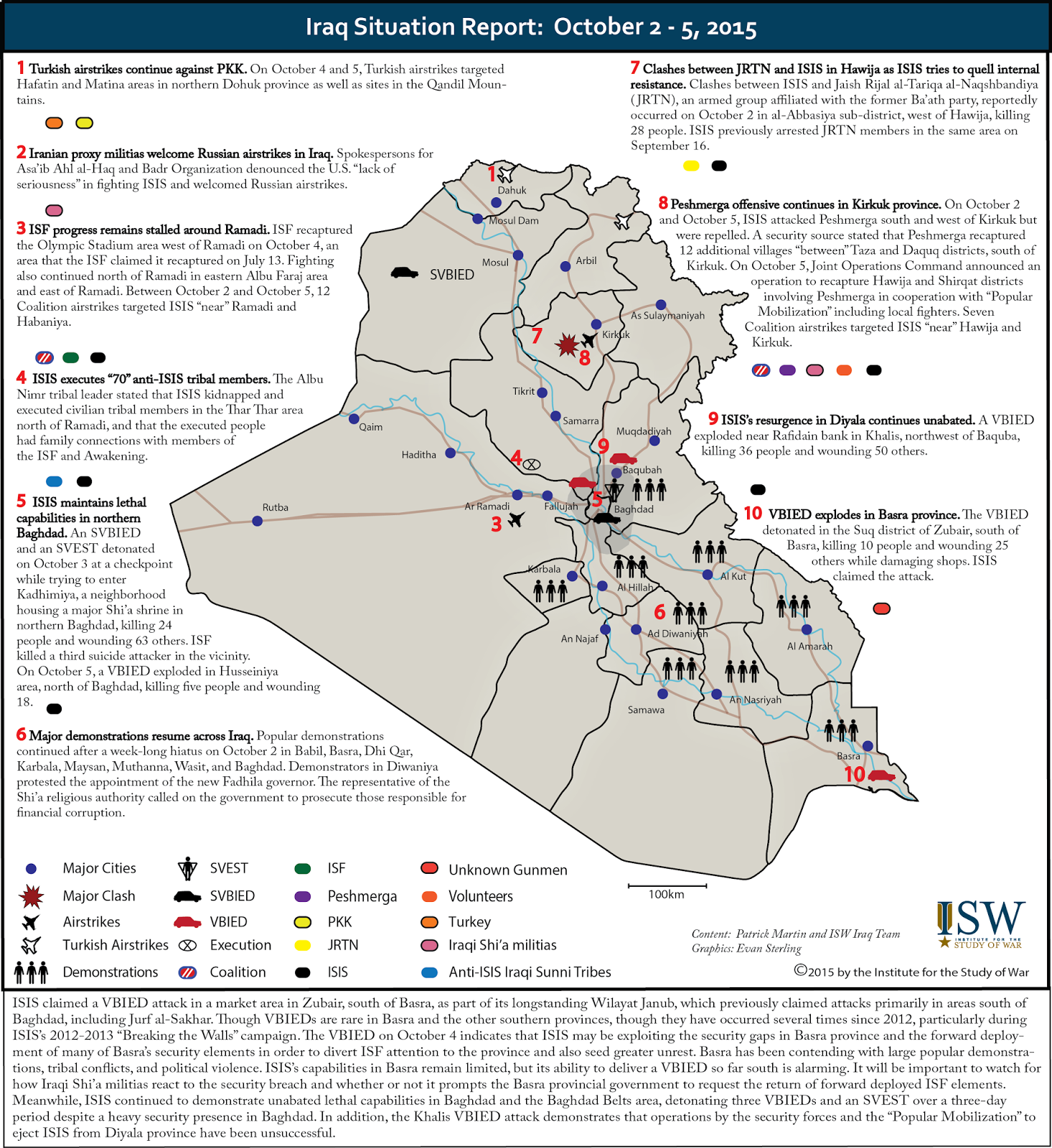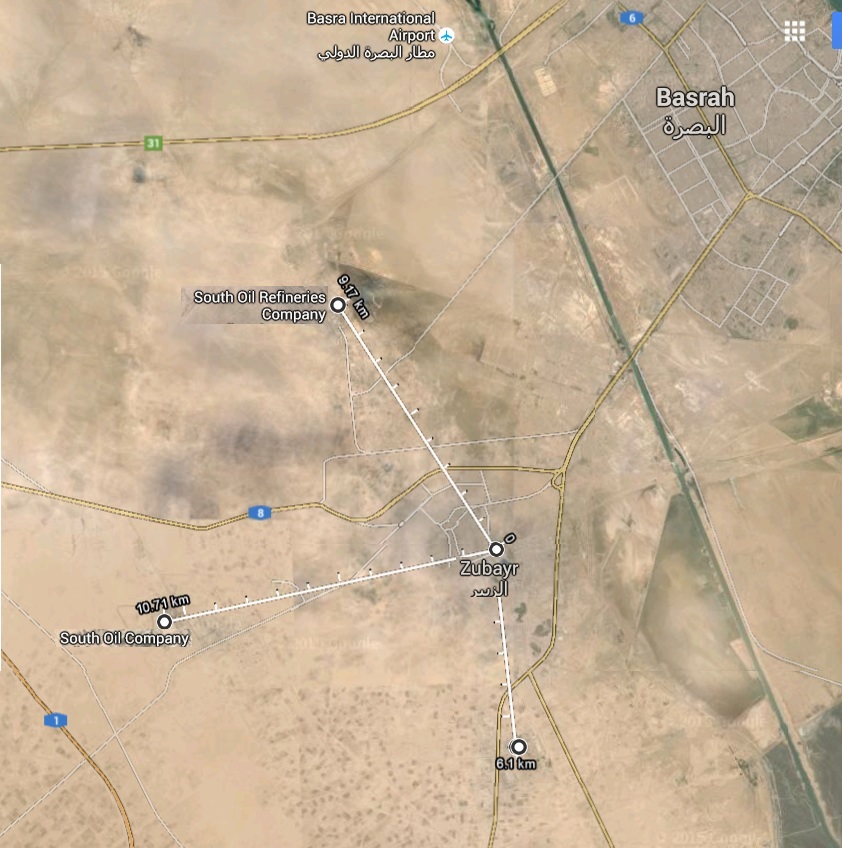The following graphs use data from the latest Article IV consultation report published by the International Monetary Fund (IMF) in August 2015. All IMF papers on Iraq are here.
Government Revenues
Fig 1: Actual and projected revenue
The above graph shows the budget’s very high dependency on oil revenues. They peaked in 2012 as a result of Iraq’s declining oil export prices. In its projection the IMF assumes steadily rising oil prices (blue line) and oil exports (blue dotted line, 4.4 mb/d by 2020 from 5.5 mb/d production) so that oil revenues can almost double over 5 years.
Revenue History
Fig 2: Four IMF reports and their projections
The August 2007 report underestimated revenue due to high oil prices up to 2008 and then again during the high oil price period 2010-2012. In contrast, the July 2013 report was much too optimistic by assuming oil production would be 5.7 mb/d by 2018 with oil prices near $90 levels.
Government expenditure
Fig 3: Expenditure vs Revenue
Expenditure peaked in 2013 and then dropped slightly, trying to follow the declining revenue trend. The graph shows how difficult that is. Expenditure for salaries, pensions and the social safety net cannot be reduced otherwise there will be more social unrest than there already is. The government bought less goods and services and halted the growth of investment expenditure for 3 years until 2016.
Budget Balance
Fig 4: Budget balance 2004-2014-2020
We can see that the oil price drop after 2012 has a worse impact on the budget than the aftermath of the 2003 war and the 2009 financial crisis.
External Account
Fig 5: Balance of Payments
Iraq’s external account has also slipped into minus after 2012 (financing requirement).
Fig 6: GIR time series
Gross international reserves grew to $US 80 bn 2013 but then dropped to $US 50 bn in 2015.
Fiscal Breakeven oil price
Fig 7: Fiscal breakeven oil price
The fiscal breakeven oil price is dropping after its peak in 2013 because oil exports are increasing and expenditure is decreasing. When expenditure starts to grow again revenue growth is assumed to be faster.
IMF’s August 2015 report does not contain any breakeven calculations but its Regional Energy Outlook for MENAP countries of May 2015 has for Iraq $110 (2012) and $70 (2015)
Fig 8: IMF breakeven oil prices estimated in May 2015
https://www.imf.org/external/pubs/ft/reo/2015/mcd/eng/pdf/mreo0515oec.pdf
However, the August 2015 report had Iraq’s export price at $106.7 in 2012 and the budget was in the plus – meaning that the breakeven price was lower ($96.6 calculated for Fig 7)
Crude oil production
Fig 9: Actual crude oil production and IEA scenarios
IEA’s World Energy Outlook in 2012 gave the likely upper and lower bounds of Iraq’s crude oil production up to 2020 (green lines). The Medium Term Oil Market Report of February 2015 predicted something in between. The latest OMR (October 2015) writes:
|
Iraq is currently the world’s fastest source of supply growth: average output of 4.2 mb/d during 3Q15 was 1 mb/d above a year ago. But oil’s collapse and Iraq’s severe financial crisis have forced the government to curb spending, hence output next year is likely to remain broadly flat versus 3Q15 levels. But Iraq has made impressive strides during this time – vaulting past its neighbour (Iran) to become OPEC’s second biggest producer after Saudi Arabia. It is now exporting three times as much as Iran, with oil sales breaching 3.6 mb/d during September. But it may prove a challenge for Iraq to sustain such lofty export rates due to its financial difficulties. Oil’s decline to $50/bbl from a June 2014 peak above $115/bbl has forced Baghdad to renegotiate service contracts with international oil companies. And with a major investment opening in Iran on the horizon, Iraq will be under pressure to ensure its contract terms are competitive. https://www.iea.org/media/omrreports/fullissues/2015-10-13.pdf |
Crude oil exports
Fig 10: Oil fields and infrastructure in Southern Iraq
http://www.iea.org/publications/freepublications/publication/WEO_2012_Iraq_Energy_OutlookFINAL.pdf
Iraq’s oil export outlets are concentrated on a very narrow strip of land between Kuwait and Iran. The offshore terminals are vulnerable to inclement weather, usually around May/June each year.
Fig 11: Iraqi crude oil exports
The Somooil website does not seem to be available anymore but monthly updates are published here: https://www.rebuildingiraq.net/more-news
Note that the 3.6 mb/d mentioned in the IEA OMR October 2015 is not in line with quotes of the Ministry of Oil:
“The Iraqi Ministry of Oil announced its oil exports for the previous September 2015 which was (91.552.863) barrels and their achieved outcome which is about (3.692) billion dollars according to the statistics of SOMO company.”
91.55 million barrels over 30 days would be 3.05 mb/d as shown in Fig 11.
Fig 12: Actual crude oil exports and IEA scenario
Fig 13: Destination if Iraqi exports by continents
Fig 14: Iraqi oil exports by destination country in2014
http://www.eia.gov/beta/international/analysis.cfm?iso=IRQ
Security situation
Fig 15: Iraq situation report October 2015
http://iswresearch.blogspot.com.au/2015/10/iraq-situation-report-october-2-5-2015.html
The above map shows the security situation as at beginning of October 2015. The main battle is going on in the North and West of the country. The South, controlled by Shia, has been comparatively quiet although there have been demonstrations on power cuts, water quality and insufficient employment of local residents in the oil industry.
Iraq protesters threaten Basra oil exports
5/8/2015
Furious residents of southern Iraq’s main port city of Basra have threatened to disrupt oil exports amid mounting protests against the government over corruption and infrastructure failures.
https://now.mmedia.me/lb/en/NewsReports/565689-iraq-protesters-threaten-basra-oil-exports
Iraqis complain of poor government services as heat rises
5/8/2015
Iraqis complaining about corruption and poor services, epitomised by power cuts during a heatwave, took to the streets on Tuesday, underlining the pressures on a government struggling to fend off radical insurgents.
http://in.reuters.com/article/2015/08/05/iraq-protests-electricity-idINKCN0Q926R20150805
And more recently:
Fig 16: After a car bomb explosion in Zubair
3 dead, 35 wounded in car bombing in Zubair District in Basra
5/10/2015
(IraqiNews.com) Basra – Head of Zubair District Council in the province of Basra announced on Monday, that 3 civilians have been killed and 35 were injured in a car bomb blast in the district.
http://www.iraqinews.com/iraq-war/3-dead-35-wounded-car-bombing-zubair-district-basra/
IS claimed responsibility but Basrah’s governor announced 2 days later that the mastermind of the bomb attack was arrested, reportedly coming from the nearby Faw district.
Let’s have a look where Zubair is located:
Fig 17: Location of Zubair town with neighbouring oil infrastructure
Not far from oil installations and refineries. The Zubair oil field produces 200 kb/d.
Conclusion
If oil prices remain low Iraq will not get out of its current budget deficit. That will worsen all other problems this country is already suffering from.
Previous posts:
15/6/2014
World’s untested assumption on 6 mb/d of Iraqi oil by 2020
http://crudeoilpeak.info/worlds-untested-assumption-on-6-mbd-iraqi-oil-by-2020
9/8/2013
Iraq crude oil exports stall amid pipeline attacks
http://crudeoilpeak.info/iraq-crude-oil-exports-stall-amid-pipeline-attacks
16/3/2013
Iraq war and its aftermath failed to stop the beginning of peak oil in 2005
http://crudeoilpeak.info/iraq-war-and-its-aftermath-failed-to-stop-the-beginning-of-peak-oil-in-2005

